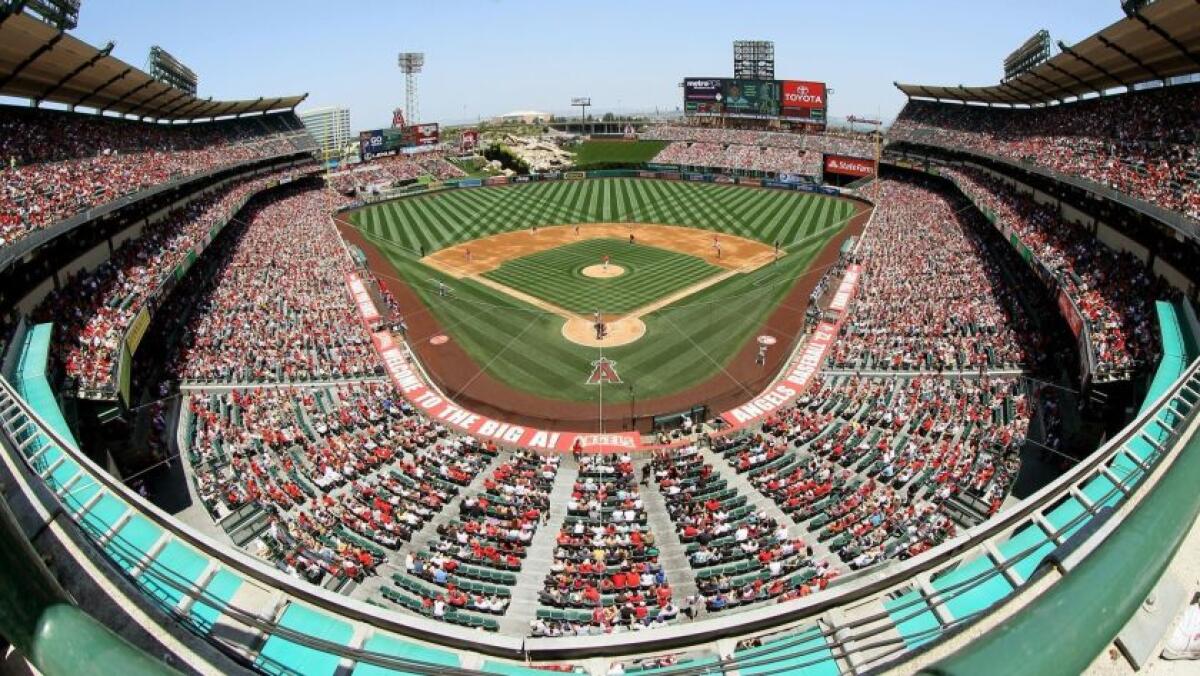Q&A: What the future may hold for Angels broadcasts with the uncertainty of Bally Sports

- Share via
Imagine this: August has come, and with it an exciting and long-overdue pennant race for Shohei Ohtani and Mike Trout and all the Angels.
You could watch the games on MLB Network, which provides baseball programming all day, then airs the Angels in the Los Angeles market, including an Angels pregame show and postgame show.
You could stream the games wherever you are, including locally without a cable or satellite subscription, and in other geographical regions in which Angels games currently are blacked out.
Those are among the concepts under discussion within the headquarters of Major League Baseball, where league officials are trying to navigate a perilous financial dilemma and take one giant step into a brave new world, where the regional sports network is an endangered species and fans pay the league directly to watch whatever team they want, however they want to watch and wherever they live.
There is a long and uncertain path from here to there, and we have some answers.
Are the Angels about to go off the air?
No. The Cactus League opener remains scheduled to air Feb. 25 on Bally Sports West.
What is the perilous financial dilemma?
Diamond Sports Group, which operates regional sports networks under the Bally name, said Wednesday it would not make $140 million in payments owed to its lenders. Diamond is widely expected to file for bankruptcy, putting at risk the roughly $1 billion it owes this year to the 14 major league teams that play on Bally channels, including the Angels on Bally Sports West.
Shohei Ohtani’s impending free agency looms large, but what are other story lines for the Angels heading into spring training ahead of the 2023 season?
How much is at risk for the Angels this year?
A little more than $125 million, according to a person familiar with the matter who declined to be identified. In 2022, Forbes estimated the Angels generated $331 million in annual revenue.
“What Diamond has been saying to us is that they intend to pay the clubs,” Commissioner Rob Manfred said in a news conference Wednesday in Phoenix. “A lot of clubs have payments due between today and the first day of the season, or the first of April. So it’s a day-to-day thing.”
If those payments stopped, could the league replace all of the revenue promised to the 14 teams on Bally channels?
“Not in the short term,” Manfred said.
So what would happen?
“If Diamond doesn’t pay,” Manfred said, “under every single one of the broadcast agreements, that creates a termination right, and our clubs will proceed to terminate those contracts. In the event that MLB stepped in, what we would do is we would produce the games.”
He said MLB would negotiate with cable and satellite companies to carry the games. With cable and satellite audiences dwindling, it is doubtful the companies would be willing to pay as much as the current Bally contracts pay.
Blackout rules were designed to force fans to subscribe to cable or satellite, to protect the investment made by the regional sports network. But, if that network goes away — or, at minimum, no longer carries an MLB team — Manfred said the league would want to offer in-market streaming packages for fans who preferred to watch their home team without a cable or satellite subscription.
How much might an Angels-only streaming package cost?
Too soon to tell. Bally Sports offers streaming of its regional sports networks at $20 per month, which includes major league teams in some markets but not in the Los Angeles market. In Boston, NESN offers a streaming package of the Red Sox and NHL Bruins for $30 per month.
MLB might require fans to subscribe to the league’s MLB.TV streaming service, currently priced at $25 per month for every out-of-market game or $130 for games of a single team for an entire season.
“When you look at MLB.TV,” Manfred said, “you go in, and you can buy your out-of-market package like you always have, but you would have the option to buy up into in-market games, something the fan has never had before, which I see as a huge improvement for fans.”
Arte Moreno has a long to-do list and not much time to convince the Angels fan base that he is the right owner for one of this market’s crown-jewel franchises.
If Diamond does file for bankruptcy, can MLB implement all of these plans right away?
Probably not right away, and maybe not at all.
For Diamond, the preferred approach would be what is called a “prepackaged bankruptcy,” in which the company says, “We cannot pay all of our bills, but we have reached deals with our creditors.” The bankruptcy court often — but not always — approves such a package.
Diamond has asked MLB to grant the company streaming rights. MLB has declined because the league is not persuaded such a grant of rights would resolve Diamond’s financial crisis.
Without agreement among Diamond and its creditors, the bankruptcy court makes the decisions. The court may or may not do what MLB wants.
Why is MLB so confident in proposing to produce its own broadcasts?
Fans want to watch their home team, and the league believes there is money to be made. Among the 29 teams based in the United States, 22 teams delivered the highest-rated prime-time programming on cable television within their market last summer. (Nielsen does not provide ratings for Canada.)
Angels’ two-way star Shohei Ohtani has ended his eight-year relationship with Asics to sign a long-term deal with New Balance.
Are the Dodgers impacted by the potential Diamond bankruptcy?
No. The Dodgers are paid for their SportsNet LA channel by Charter Communications, which generated $54 billion in revenue last year and turned a profit of $5 billion.
What other local teams air on the Bally channels?
The Clippers, Ducks and Kings. The Clippers already offer fans alternatives to the Bally regional sports network, with a team-run streaming service called Clipper Vision, and a selection of games on Channel 5.
More to Read
Go beyond the scoreboard
Get the latest on L.A.'s teams in the daily Sports Report newsletter.
You may occasionally receive promotional content from the Los Angeles Times.














